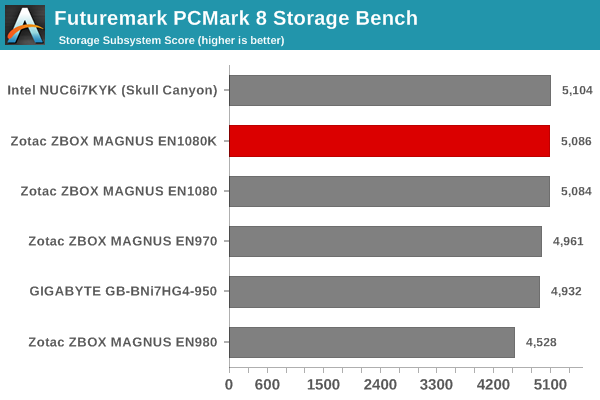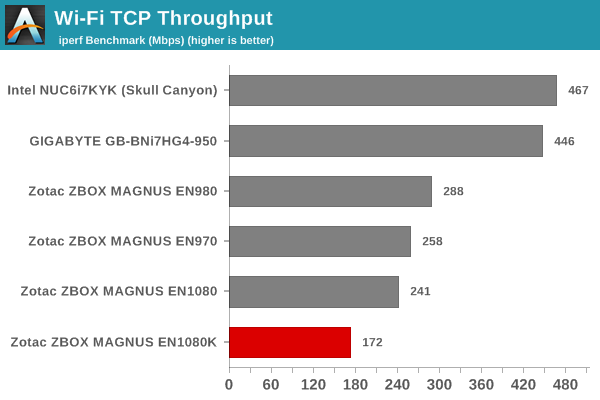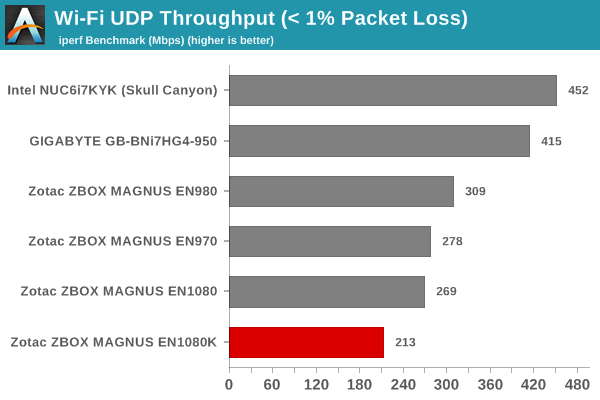Zotac ZBOX MAGNUS EN1080K Compact Gaming PC Review
by Ganesh T S on January 2, 2018 8:00 AM ESTNetworking and Storage Performance
Networking and storage are two major aspects which influence our experience with any computing system. This section presents results from our evaluation of these aspects in the Zotac ZBOX MAGNUS EN1080K. On the storage side, one option would be repetition of our strenuous SSD review tests on the drive(s) in the PC. Fortunately, to avoid that overkill, Futuremark's PCMark 8 has a storage bench where certain common workloads such as loading games and document processing are replayed on the target drive. Results are presented in two forms, one being a benchmark number and the other, a bandwidth figure. We ran the PCMark 8 storage bench on selected PCs and the results are presented below.


As expected, the EN1080K performs similar to the EN1080 since we are using the same Toshiba OCZ RD400 in both builds. It is not the fastest PCIe SSD around, but, is a definite step up from all the SATA SSDs we have used in some of the previously evaluated systems.
On the networking side, we restricted ourselves to the evaluation of the WLAN component. Our standard test router is the Netgear R7000 Nighthawk configured with both 2.4 GHz and 5 GHz networks. The router is placed approximately 20 ft. away, separated by a couple of drywalls (as in a typical US building). A wired client is connected to the R7000 and serves as one endpoint for iperf evaluation. The PC under test is made to connect to either the 5 GHz (preferred) or 2.4 GHz SSID and iperf tests are conducted for both TCP and UDP transfers. It is ensured that the PC under test is the only wireless client for the Netgear R7000. We evaluate total throughput for up to 32 simultaneous TCP connections using iperf and present the highest number in the graph below.

In the UDP case, we try to transfer data at the highest rate possible for which we get less than 1% packet loss.

We need to clarify one important aspect in the above graphs. The numbers for both the EN1080 and the EN1080K should be similar. However, due to a recent change in the lab environment for the PCs, we are no longer able to recreate the same WLAN testing environment for the new PCs. As we evaluate more systems, we will phase out the results derived with the older setup. That said, the comparison of the relative numbers is still valid. The 1x1 802.11ac radio is not a great choice for a flagship system, but, it is somewhat made up for by the dual gigabit LAN ports.










12 Comments
View All Comments
Sane Indian - Tuesday, January 2, 2018 - link
Why Mini PCs cost more than a Laptop or proper desktops?https://www.acer.com/ac/en/US/content/predator-mod...
TheinsanegamerN - Tuesday, January 2, 2018 - link
Because it is even MORE tech, more power hungry, with more cooling then any laptop, in a smaller space, with a smaller market?DanNeely - Tuesday, January 2, 2018 - link
Even lower production volumes than laptops, meaning each sale has to cover a larger chunk of the total R&D budget.nerd1 - Tuesday, January 2, 2018 - link
It does NOT cost more than equivalent laptop (7700 and GTX 1080)Rookierookie - Tuesday, January 2, 2018 - link
On Newegg, a Clevo laptop with i7-8700K, GTX 1080, 32GB RAM, 512GB SSD+1TB HDD goes for $2449. So pretty darn close.JoeyJoJo123 - Tuesday, January 2, 2018 - link
"free" keyboard, mouse, display included with the Clevo, as well. And the thinner profile more easily fits into a backpack or carrying bag, as opposed to a cube-like shape.cosmotic - Wednesday, January 3, 2018 - link
At least the zotac doesn't look like a tragedy like the Clevo.Death666Angel - Wednesday, January 3, 2018 - link
The Zotac EN1080K goes for 1910€ in Germany. Cheapest 1080 laptop is and ASUS ROG with a 6700HQ, 512GB SSD and 16GB RAM. 6-core 8700 based Schenker Laptop (Clevo rebrand) goes for 2820€. The Zotac with 512GB SSD and 16GB RAM is 2200€, plus OS, so maybe 2250. But for that I would bet you get better cooling and much better IO options. Sure, you lose the built in display and peripherals, but they serve different use cases. If you want a luggable, portable solution, why look at this thing. If you want a stationary thing that is out of the way, why look for a laptop with a large footprint.Flunk - Wednesday, January 3, 2018 - link
It's mostly because the Clevo is enormous. You pay for the engineering to get something this small.Flunk - Wednesday, January 3, 2018 - link
This is also a bit of boutique system, they're not going to sell many of these.